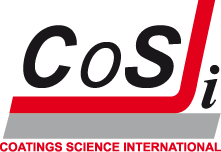Speakers COSI 2007
- Professor Hans Juergen Adler, Technische Universitaet Dresden, Germany, Ultrathin layers as new concepts for corrosion inhibition and adhesion promotion
- Masahiko Akahori, Nippon Paint Co. Ltd, Japan, Radical shower technique using a remote plasma reactor
- Dr. Ingo Alig, Deutsches Kunststoff-Institut, Germany, Microcalorimetery for characterization of film formation and cure of coatings and adhesives
- Rong Bao, Fusion UV Systems Inc. USA, A new method of analyzing double bond conversion as a function of film thickness
- Keimpe J. van den Berg, AkzoNobel Car Refinishes, The Netherlands, Development of waterborne UV-A curable clear coat for car refinishes
- Professor Fred Brouwer, Van't Hoff Institute of Molecular Sciences, University of Amsterdam, The Netherlands, Real-time imaging of film formation using fluorescence spectroscopy
- Pascal Bru, Formulaction, France, Film formation of coatings studied by diffusing wave spectroscopy
- Professor Stuart Croll, North Dakota State University, USA, The interplay of physical aging and degradation weathering for two crosslinked coatings
- Michael Dornbusch, BASF, Germany, The use of modern electrochemical methods in the development of corrosion protective coatings
- Dr. Daniel de la Fuente, Max Planck Institute for Iron Research, Germany, Fundamental investigation on the stability of the steel/coating interfaces contaminated by submicroscopic salt particles
- Dr. Matthijs Groenewolt, BASF, CTR-Forsung, Germany, Innovative highly scratch resistant clear coats
- Marta Klanjsek Gunde, National Institute of Chemistry, Ljubljana, Slovenia, Dispersions of carbon black pigments in epoxy-based medium
- Tsuginori Inaba, Chuo University, Japan, Double bonding strength due to pre-treatment on metal surface for plasma spray with low pressure arc after grit blasting
- Rob Jans, Akzo Nobel Decorative Coatings Europe, The Netherlands, A new reactive diluent for decorative paints in view of 2010
- Professor Diethelm Johannsmann, Clausthal University of Technology, Spatially resolved maps the stress distributions occurring during drying of latex dispersions
- Dr. A.P. Kharitonov, Russian Academy of Sciences, Russia, Enhancement of commercial properties of polymeric articles by direct fluorination
- Dr. Sviatlana Lamaka, University of Aveiro, Portugal, Hybrid organic-inorganic sol-gel films as anticorrosion coatings for magnesium alloy AZ31B
- Sheun-Hwa Ma, Dupont, Germany, Structured acrylic polymers and their use in coating application
- Frank J. Maile, Merck, Germany, Orientation of transparent effect pigments and its influence on their appearance in polymer films
- Dr. Jacky Mallégol, Arcelor Research Industry Liege, Belgium, UV weathering of prepainted steel
- Professor Eva Malmström, KTH, Sweden, Covalent surface modification by controlled polymerization
- Professor Akira Matsumoto, Kansai University, Japan, Design of network polymers based on multivinyl crosslinking polymerization
- ir. Leendert Molhoek, DSM Resins, The Netherlands, Amorphous polyamide resins; new versatile binders for fast curing powder coatings
- Dr. Rolf Nothhelfer-Richter, Institut fur Polymerchemie, Universitaet Stuttgard, Germany, Investigations of the photocatalytic activity of pigments and pigmented organic coatings using the reactor method
- Dr. Jürgen Omeis, BYK-Chemie GmbH, Germany, The evolution of structured copolymers for coating applications
- Dr. Mark Plehiers, Sigma Coatings SA, Belgium, Synthesis of silyl acrylates for marine coatings
- Professor Wengfang Shi, University of Science and Technology of China, Hyperbranced acrylate prepolymers and their potential applications for UV powder coatings
- Willem Jan Soer, Eindhoven Univeristy of Technology, The Netherlands, Novel Crosslinking Systems for Surfactant-free Latexes Based on Maleic Anhydride Containing Polymers
- Milena Spìrková, Institute of Macromolecular Chemistry, Czech Republic, The view form the core onto the surface of self-assembled nanocomposite coatings
- Jeffrey M. Stubbs, DSM NeoResins, USA, The dynamics of morphology development in multi-phase latex particles
- Dr. Katia Studer, Ciba Speciality Chemicals Inc, Switzerland, Novel curing agents: thermal radical initiators as viable alternatives to peroxides
- Janice Tardiff, Ford Motor Company, USA, Automotive pretreatment - limitations of existing technology and enablers for future technology
- Nikhil Verghese, Dow Chemical Company, USA, The effect of rigid inorganic fillers on the mechanical and thermo-mechanical properties of epoxy thermosets: experimental and theoretical considerations
- Di Wu, Eindhoven University of Technology, The Netherlands, Nature-inspired Superhydrophobic Coating

Professor Hans-Juergen P. Adler
Institute of Macromolecular Chemistry and Textile Chemistry, Technische Universtitaet Dresden, Germany
Title lecture
Ultrathin layers as new concepts for corrosion inhibition and adhesion promotion
Author
Prof.dr. Hans-Juergen P. Adler
Abstract
It will be shown that ultrathin self-assembled layers of bifunctional
alkyl- spacered phosphonic acids on metal oxide surfaces can affect
adhesion promotion and corrosion inhibition. The results show that these
molecules are able to adsorb spontaneously onto the metal surface and
subsequently a structured molecular order is formed. We have synthesized
molecules with different spacer length, and different head groups, like
thiophene, pyrrole, dithienylpyrrol, and have copolymerized them
on the ultrathin surface layer.
The stability of metal/polymer interfaces is frequently determined by
electrochemical reactions. For ion-permeable coatings a diffuse double
layer is formed at the interface and all electrochemical reactions
including corrosion reactions are slowed down considerably. In the
presence of defects however ions will be able to diffuse along the
interface metal/polymer, the ionic strength at the interface increases
and the rate of electrochemical reactions is speeded up. As the results
of differering electrode kinetics between the intact interface and the
defect a galvanic element is set up, the defect being the anode and the
intact interface being the local cathode. At the cathode oxygen is
reduced and the reaction products may destroy the interface by an
oxidative attack or the substrate by electrolytic corrosion. In any case
deadhesion results.
We have developed a new release system for corrosion protection on
the basis of polypyrrole interface between the metal and an
organic coating system. The lecture will discuss some fundamentals of
the self-assembling process, the characterisation of the order in the
thin films, the electrochemically driven deadhesion reaction as well as
new technological concepts for the design of interfaces with superior
stability.
- Intelmann C.M., Rammelt U., Plieth W., Cai, X., Jähne E., Adler H.-J.P. (2006), Preparation of ultrathin polypyrrole films using an adhesion promoter, J.Solid State Electrochem, Vol 11, Nr.1(2007) 1-9
- Busch G., Jaehne E., Cai X., Oberoi S., Adler, H.-J. P. (2003): Ultrathin layers for adhesion promoters. Synthetic Metals 137, 871-872
- Pich A., Lu Y., Adler H.-J. P., Schmidt T., Arndt K.-F. (2002): Dispersion Polymerization of pyrrole in the presence of poly(vinyl methyl ether) microgels. Polymer 43, 5723 - 5729
- Mäge I., Jähne E., Henke A., Adler H.-J. P., Bram C., Jung D., Stratmann M. (1998): Self-Assembling Adhesion Promoters for Corrosion Resistant Metal Polymer Interfaces.Progress in Organic Coatings 34 , 1-12
Biography
Prof.Dr. Hans-Juergen P.Adler, TU Dresden, Institute for Macromolecular Chemistry and Textile Chemistry
- Born 1941 in Pirna, Saxony,Germany
- 1960 - 62: Vocational training as skilled worker for fiber spinning
- 1962 - 67: Studying Chemistry at Institute of Chemical Technology, Merseburg - Halle,Germany
- 1967 - 68: Scientific Assistant at Institute for Cellulose and Paper, Heidenau,Germany
- 1971: PhD at Technische Universität Dresden, in Macromolecular Chemistry, Germany
- 1971 - 85: Junior Group Leader at the same institute
- 1980 - 81: Postdoc at Institute for Macromolecular Chemistry, Prague, Czech Republic
- 1984: Habilitation for Macromolecular Chemistry and Textile Chemistry at TU Dresden
- 1985: Moving to Western Germany due to political reasons
- 1985 - 86: Research Manager at the Non-Wovens Company "Corovin" GmbH in Peine, Germany
- 1986 - 93: Research Manager at Akzo Coatings GmbH, Stuttgart, Germany
- in 1993: Research Manager at Lackfabrik Frei, Bräunlingen, Germany
- since 1993: Full-Professor and Director of the Institute of
Macromolecular Chemistry and Textile Chemistry, TU Dresden
- 1995-2007 Speaker of the Collaborative Research Project (SFB287) of the German Research Foundation (DFG) "Reactive Polymers in Inhomogeneous Systems, in Melts and at Interfaces" with 20 projects in 7 institutes in Dresden, Germany
- 2001-2004 Speaker of the European Graduated School "Advanced Polymeric Materials" (Prague, Czech Republic, Gliwice, Poland, Dresden, Germany) of the DFG
- Chairman of the expert group "Paints and Pigments" (APi) of GDCh (Society of German Chemists) 2000-2005
- President of the European Paint Association "FATIPEC" for the period 2001 - 2002 and Chairman of the XXVI International FATIPEC-Congress in Dresden (Sept. 9-11, 2002)
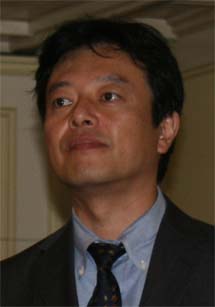
Masahiko Akahori
Nippon Paint Co., Ltd. R&D division, Tokyo Technical Center, Tokyo, Japan
Title lecture
A new test method for weatherability prediction of coatings: radical shower technique using a remote plasma reactor
Author
M. Akahori
Abstract
The exterior wall of
houses in Japan are refurbished or re-painted every 7-10 years due to
deteriorated coating conditions. In the point of the sustainable
housing, it is necessary to have a lifetime of 30 years. Although there
are several new durable paints now under development, it is difficult to
predict the durability during 30 years long with conventional
acceleration methods like the Super UV weather-test machine or the Xenon
machine.
A new test method for
weatherability prediction using a Remote Plasma Reactor has been
studied. We studied the degradation mechanism, by focusing on the fact
that exposure to radicals strongly influences the durability of
coatings. As a means of direct radical irradiation on the coatings, we
used a plasma-generating device. More specifically, in order to
investigate changes not only in color and gloss, but also surface
changes (SEM, and FTIR technique) through a down-flow type device
(Remote Plasma), the weatherability of enamel type coatings was studied.
This Remote Plasma method
showed that obtained results correlated with the outdoor exposure test
very well and especially acceleration behavior with test time was well
controlled. Moreover, this radical shower method can be applied for
other materials such as plastics and rubbers.

Biography
Masahiko Akahori
Nippon Paint Co., Ltd.
R&D Division
Japan
Educational Background
- 1987 Master Degree at Doshisha University
Work Experience
- 1987 - 1997 Research Chemist at Kanebo Co., Ltd.
- 1997 - Present: Research Chemist at Nippon Paint Co., Ltd.
- 2001- 2005 A member of National Project for Research and Development of House Technology Creating Life Values.
Research Interests
- Synthesis and applications of polymeric materials
- Development of adhesive and coating products
- Evaluation on weatherability and durability of polymer materials
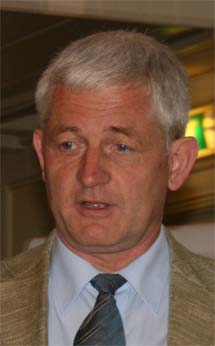
Dr. Ingo Alig
Deutsches Kunststoff-Institut, Darmstadt, Germany
Title lecture
Microcalometry for characterization of film formation and cure of coatings and adhesives
Authors
I. Alig, D. Lellinger, H. Oehler, S.A. Adamovsky and Ch. Schick
Abstract
During film formation and/or cure of coatings and adhesives changes in
physical properties and chemistry of the material occurs. For material
development and characterization one has to consider the complex
interplay between drying, chemical reaction and/or vitrification. In
order to get a deeper insight into the mechanisms of film formation, it
is desired to monitor the changes of the physical properties in real
time.
Calorimetry, particularly differential scanning calorimetry (DSC),
belongs to the standard techniques for polymer characterization. DSC
measurements allow detecting glass and phase transitions,
melting/crystallization temperatures, specific heat and heat of reaction
or phase transitions for polymeric materials. With extensive laboratory
automation and use of combinatorial methods for material development,
there is an increasing interest in fast and/or parallelized methods for
industrial laboratories. To achieve high throughput calorimeters with
automatic sample changers has been developed [1]. Sensor arrays [2] are
not yet optimizes from a calorimetric point of view. However, one of the
limitations of calorimeters for characterization of coatings is the
difficulty to study films with open surfaces (e.g. drying of coatings at
defined relative humidity).
In this paper we describe a recently developed multi-channel
microcalorimeter with flat calorimetric sensors enabling such analysis
[3]. The sensors (Fig. 1) are based on commercial top glasses for
microscopy with heaters and thermocouples sputtered on upper and lower
side, respectively.
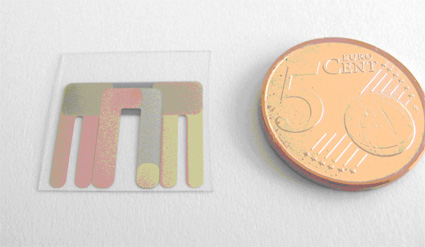
Fig.1: Calorimetric sensor for coatings (glass plate: 20x20 mm, thickness 150 μm).
The principle of the setup is similar to so-called thin film calorimeters [4-6], but the sensors are more robust and therefore easier to handle. The hard and software arrangement allows isothermal measurements and experiments with well defined cooling or heating rates. In all cases temperature-modulated experiments are possible. The setup allows to measures the real and imaginary part of the complex specific heat capacity (from amplitude and phase of the heat flow) and the latent heat due to drying or reaction. The setup has applied for monitoring of film formation from aqueous dispersions or solvent-based coatings, for curing of epoxies and acrylates, and IR curing of powder coatings.
References:
- M.F.J. Pijpers; V. B. F. Mathot; B. Goderis; et al. Macromolecules 35 (2002) 3601.
- J. Bennett, Proc. NATAS 2002 (2002) 150.
- AiF Project "Neuartiges Mikrokalorimeter zur Hochdurchsatzcharakterisierung von Polymermaterialien" (AiF Nr. 138 ZGB).|
- D. W. Denlinger; E. N. Abarra; K. Allen; P. W. Rooney; M. T. Messer; S. K. Watson; F. Hellman, Rev. Sci. Instrum. 65 (1994) 946.
- S. A. Adamovsky; A. A. Minakov; C. Schick, Thermochim. Acta 403 (2003) 55.
- http://www.xensor.nl/.
Curriculum vitae
Ingo Alig (Ph.D., D.Sc.)
Head of Department of Physics at Deutsches Kunststoff-Institut in
Darmstadt, Germany lecturer at Technical University Darmstadt
EDUCATION
Ph.D. 1983 in Physics, Technical University Merseburg Habilitation
(D.Sc.) 1988 in Experimental Physics
POSITIONS
- 1978-1991 Senior scientist at Department of Physics at Technical University Merseburg 1989-91 visiting scientist at Research Center of Crete/Greece, McMasters University Hamilton/Canada, Max Planck Institute for Polymer Science
- 1991-1993 senior scientist at the Institute for Physical Chemistry of University Köln
- 1993-now Head of department of Physics at the Deutsche Kunststoff-Institut and lecturer at Technical University Darmstadt
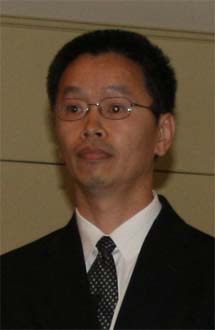
Rong Bao
Fusion UV Systems Inc. USA
Title lecture
A new method of analyzing double bond conversion as a function of film thickness
Authors
R. Bao and S. Jonsson
Abstract
A new method of analyzing a depth profile of double bond conversion as a
function of film thickness will be presented. By using a
combination of statistical calculation and FTIR, a new approach to
analyze the depth profile of conversion "layer by layer" in the
characterization of photo polymerization will be discussed.
Utilizing a formula (X1 + X2 +.... Xn) / n = Average conv. n = 1,2,3....
n: a number of layer (5 microns), an average conversion of any 5 micron
section can be calculated from prior 5 micron conversion and total
average conversion. More detail information of photo-polymerization,
such as the depth profile of conversion and a difference in conversion
between the top 5 microns and the bottom 5 microns in a 25 micron film
as a function of film thickness can be obtained.
This investigation will be accomplished using a variation of film
thickness, photo bleaching PhI (Irg. 819) and un-photo bleaching PhI
(Irg. 184) as well as the concentration of PhIs in the presence of air
and in absence of air. Some commercial formulations will also be
analyzed using this new approach. An influence of mixture of PhIs on the
double bond conversion at given depth of a cured film in a 25‑micron
film will be discussed. Results of analyzing double bond
conversion between traditional FTIR and the new approach (statistical
calculation / FTIR) will be compared.
Biography
Rong Bao got his Ph. D. for organic chemistry at Nankai University of P. R. China in 1988. From 1994 to 1996, Rong Bao worked at the Center for Photochemical Sciences in the Bowling Green State University of OHIO with Dr. Neckers as a research associate. Since 1996, Rong Bao joined the Fusion UV Systems, Inc as a research fellow for UV curing. His major research interest is photochemistry, photo polymerization and new UV lamp applications in the UV curing field. He has published more than 40 papers in different scientific journals and RadTech conferences.

Keimpe J. van der Berg
AkzoNobel Car Refinishes, Sassenheim, The Netherlands
Title lecture
Development of Waterborne UV-A curable clear coat for car refinishes
Authors
K.J. van der Berg, L.G.J. van der Ven, H.J.W. van den Haak
Abstract
The development of a waterborne UV-A curable clear coat for car refinish
application will be presented. The clear coat formulations are based on
specially developed acryloyl or maleimide functional polyurethane
dispersions. The functional PUR dispersions are characterized by a
relative low molecular weight, a low Tg, a high C=C functionality and an
optimized amount of poly(ethylene oxide). The characteristics are
necessary for optimal film formation and appearance (first two),
obtaining good film properties (third) and finally (fourth) for good
emulsification and sufficient cure at the surface (less influence of
oxygen inhibition).
The synthesis of the functional PUR dispersions and its performance in
clear coats will be discussed. Several aspects on film formation (cure
kinetics, evaporation speed of water) and film properties (durability,
influence of poly-EO on surface cure, physical and chemical properties)
will be discussed. The influence of film formation and amount of poly-EO
in the PUR dispersion on durability of the final clear coat has been
studied and has resulted in an optimal monomer composition of the
functional PUR dispersion
Biography
Dr. Keimpe van den Berg obtained in 1990 his PhD in Organic Chemistry at the University of Groningen (The Netherlands). In 1990 he started his career within Akzo as researcher, working on the development of new resins and crosslinkers for coatings. This work was carried out at Akzo Resins and Akzo Nobel Central Research. In 1997 Mr. van den Berg joined Akzo Nobel Car Refinishes where he worked at several positions within R&D. He currently holds the position of Manager New Technologies within Akzo Nobel Car Refinishes.
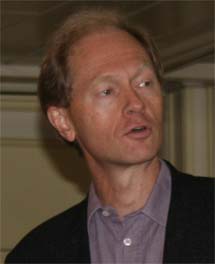
Professor Fred Brouwer
Van 't Hoff Institute of Molecular Sciences, University of Amsterdam
Title lecture
Real-time imaging of film formation using fluorescence spectroscopy
Author
F. Brouwer
Abstract
In recent years, improved instrumentation has allowed fluorescence spectroscopy to further extend its potential as an ultrasensitive detection method. Even individual molecules can nowadays be observed (almost) routinely. Using confocal microscopy, it is possible to determine a variety of fluorescence properties in a small volume element (typically an ellipsoid with a diameter of 300 nanometers and a length of 1-2 micrometers) inside a thin film within a second or less.One of the fluorescence properties that has not been extensively used in polymer chemistry is the solvatochromic shift of fluorescent dyes that have a nonpolar ground state and a very polar excited state. The emission spectrum of such a dye shifts to longer wavelengths with increasing polarity of the medium, provided that structural relaxation is possible on the time scale of the excited state lifetime (nanoseconds).In the lecture the application will be illustrated of the fluorescence solvatochromic shift and other fluorescence properties that allow separating the effects of polarity and mobility with high spatial and temporal resolution. Our first application will be the drying of latex films, labeled with fluorescent probe molecules.
Biography
Fred Brouwer studied physical-organic chemistry at Leiden University and
received his PhD there on a subject involving mainly organic
photochemistry and NMR spectroscopy. In 1987 he joined the staff of the
Organic Chemistry laboratory of the University of Amsterdam, working
initially with prof. Jan Verhoeven on photoinduced electron transfer and
related processes. Currently, he holds the John van Geuns chair in
Molecular Spectroscopy at the University of Amsterdam.
His research work involves photoinduced molecular motors, spectroscopic
studies of catalysis, and the development and application of fluorescent
probe molecules.
The application of fluorescent probes in polymer chemistry is the
subject of the presentation at COSI 2007.
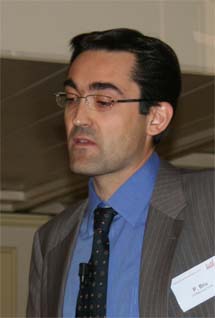
Pascal Bru
Formulaction, France
Title lecture
Film formation of coatings studied by diffusing wave spectroscopy
Author
A. Brun, H. Dihang, L. Brunel
Abstract
The coating industry is facing nowadays a growth of environmental
regulations, an imposed substitution of suspected toxic components or
solvents and a constant need of improving performances. However, these
new formulations undergo new film formation processes, influencing the
coating performance and appearance.
We have studied the film formation process of several coating systems
using a new optical technology that gives a unique and simple
information. Based on Diffusing-Wave Spectroscopy, it allows a non
intrusive measurement of the drying on the appropriate substrate
(concrete, metal, plastic, wood…). The kinetics of film formation,
displayed in real-time, provide a new vision of the successive steps of
the mechanism taking place (evaporation, packing, interdiffusion…)
as well as accurate information on drying times such as open-time or
touch-dry time, for an in-depth characterization of the film formation
process.
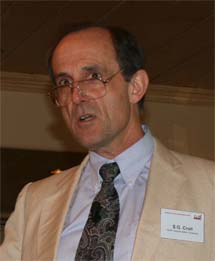
Professor Stuart Croll
Department of Coatings & Polymeric Materials, North Dakota State University, Fargo, USA
Title lecture
The interplay of physical aging and degradation weathering for two crosslinked coatings
Authors
B.M.D. Fernando, X. Shi, S.G. Croll
Abstract
Polymer molecular relaxation, or 'physical aging', is a very important
influence on permeability and mechanical properties of any polymer below
its glass transistion. 'Physical aging' occurs as even an unstressed
polymer gradually relaxes towards its equilibrium conformation. This
happens over periods much longer than the typical cycle of an
accelerated weathering test, thus important properties of a polymeric
coating may be affected by the difference in frequency between natural
and artificial exposures, in addition to other factors.
Further, 'physical aging' is affected by chemical changes to the polymer
network caused by the degradation during a weathering exposure. In this
investigation, purely physical aging was compared with the effect of
concurrent chemical degradation by measuring 'enthalpy recover' and
mechanical stress relaxation at a variety of temperatures and at various
stages during accelerated weathering exposure.
The effect of physical aging was quite apparent in both an
epoxy-polyamide coating and a polyester-urethane coating. Changes in
physical aging behaviour during degradation were different for the two
coatings, which points to further reasons for discrepancy between
accelerated weathering and natural exposure.
Biography
Stuart Croll gained a degree in physics from the University of London a long time ago, then completed a doctorate in polymer physics at the University of Leeds. He first worked in England, then moved to Canada where he studied the residual stresses in coatings that arise during curing. After a career in the US coatings industry and its suppliers, wherein he occasionally managed to do research on film formation, Dr. Croll joined the Department of Coatings and Polymeric Materials at North Dakota State University in 2000, where he is now the Chairman of the Department. His research interests are in the weathering durability of polymers and coatings, colloidal stability, phase separation and renewable resources for coating technology.
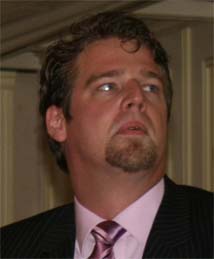
Michael Dornbusch
BASF Coatings, Germany
Title lecture
The use of modern electrochemical methods in the development of corrosion protective coatings
Author
M. Dornbusch
Abstract
The development of corrosion protective coatings will always remain a
challenge in industrial research. The application of
electrochemical methods within an industrial development is an
innovative tool to expedite the development of coatings.
The electrochemical impedance spectroscopy and the Scanning Kelvin
Probe with height control as two out of numerous methods are in the
focus of the presentation. With these methods the corrosion mechanism
and interaction between the pre-treatment and different
electrodeposition coatings could be clarified. Diffusion rates, swelling
and network density of mono and four layer coatings enhance the
comprehension of current coating products. and provide useful knowledge
for the development of new coating systems.
Furthermore the description of mechanical effects is possible allowing a
deduction of consequences for the corrosion mechanism.
Scientific cognition in industrial R&D based on results out of
these modern electrochemical methods will increase significantly
fundamental understanding and effectively speed up the progress of
corrosion protective coatings development.
Biography
10/1992 - 09/1997
Study of Chemistry at the "Heinrich-Heine-University of Düsseldorf" with
the focus of dye and photochemistry, Diploma: "Synthesis of modified
heterocyclic Retinal analoga"
01/1998-01/2001
PhD at the Institute of Organic und Macromolecular Chemistry at Prof.
Dr. H.-D. Martin at the "Heinrich-Heine-University, Düsseldorf".
Topic: "Synthesis of five-ring-membered heterocyclic Retinoids as
Chromophors for the Bacteriorhodopsin" (Model for the electronic
interaction of heterocyclic Retinoids with the protein pocket)
04/2001-09/2001
Research, production and sales responsibility at the Solvent-Innovation
GmbH, Aachen Development of new ionic liquids and process optimisation
10/2001-09/2003
Project leader at the "Max-Planck-Institute for iron research",
Düsseldorf
"Development of alternative processes for the Zn-Phosphatation for
automotive application" Clarification of the reaction mechanism from
converion baths with the substrate
10/2003 since now
Leader of the Corrosion protection basics lab at the BASF Coatings AG,
Münster
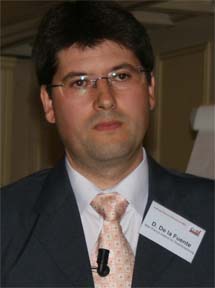
Dr. Daniel de la Fuente
Max Planck Institute for Iron Research, Dusseldorf, Germany
Title lecture
Fundamental investigation on the stability of the steel/coating interfaces contaminated by submicroscopic salt particles
Authors
D. de la Fuente and M. Rohwerder
Abstract
The presence of hydrosoluble species, mainly chlorides and sulphates, at
the metal/paint interface promotes osmotic blistering of the coating and
underfilm metallic corrosion when the concentration of the soluble salts
exceeds a critical level. Loss of adhesion and cathodic disbondment can
be also consequences of the presence of soluble salts. These processes
can lead to the deterioration of the paint system in a very short period
of time. However, since the interface is not easily accessible by
experiment, not much is known about interfacial structure, reactions and
the processes causing degradation. Scanning Kelvin Probe (SKP) is an
ideal tool for the in situ monitoring of the degradation processes at
the buried interface. On the other hand, for an in-depth understanding
it is important that the superposition of the effects of all different
parameters involved can be disentangled. Hence, it is important to
design experiments focussing on individual aspects of the complex
system.
In the present paper, a study of the fundamental aspects of the
stability of the contaminated buried steel/coating interfaces, specially
focused on the initial stages of blistering and underfilm corrosion, has
been carried out. Results of the characterization study performed with a
height-regulated SKP (HR-SKP) on surfaces contaminated at the interface
by different salt concentrations with well defined crystal size and
distribution are shown.
Biography
Dr. Daniel de la Fuente worked at the Spanish National Centre for Metallurgical Research (CENIM) from 1998 to 2006 in the Atmospheric Corrosion and Protection Group directed by Prof. Morcillo. Specialised in metallic corrosion and protection, in the research areas of corrosion in natural environments and protection by coatings, in 2006 he was awarded with an Alexander von Humboldt Fellowship and he joined the group of Dr. Michael Rohwerder at the Max-Planck-Institute for Iron Research in Düsseldorf (Germany). At present he is a post-doctoral researcher in this institute carrying out a project on the topic of Degradation Mechanisms of Metal/Polymer Interfaces Contaminated by Soluble Salts. He is co-author of numerous scientific publications in specialised international journals and he has also presented papers in the most important national and international Congresses on the speciality.
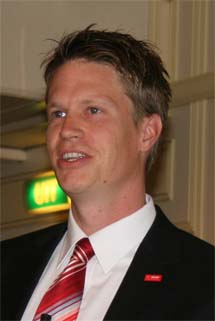
Dr. Matthijs Groenewolt
CTR- Forschung, Germany
Title lecture
Innovative highly scratch resistant clear coats
Author
M. Groenewolt
Abstract
The design of scratch resistant clear coats is still a highly desired
goal in modern coatings technology. Especially in automotive
applications, where coatings have to fulfil several demanding customer
needs simultaneously, this goal is rather challenging. For example the
coating has to be very resistant against each kind of chemicals, very
scratch resistant (=often brittle) and long term stable (=often
flexible) at the same time.
Several chemical approaches can be utilized to reach scratch resistance
of the coating, e.g. the use of nano-particles or the synthesis of
an extraordinary high crosslinking density (XLD). An innovative approach
based on a new crosslinking technology will be introduced.
It will be illustrated, that this new coating’s design provides
high crosslinking density and long term stability simultaneously.
Theoretical and experimental investigation on the degree of crosslinking
found a good correlation. In addition the nano structured features of
this system could be uncovered.
Sustainable strategies to overcome the already mentioned common problems
of highly crosslinked systemes with long term durability will be
demonstrated.
Biography
Current position: Head of the nanotechnology lab at BASF Coatings AG, Münster
Short CV Dr. Matthijs Groenewolt
- 97-01: Studies of chemistry; LMU Munich
- 00: Advanced organic studies; Universtiy of Lund, Sweden
- 01-02: Diploma thesis; Max-Planck-Institute of quantum optics, Munich
- 02-05: PhD thesis; Max-Planck-Institute of colloids and interfaces, Potsdam
- 05-present: Head of the nanotechnology-lab at BASF Coatings AG, Münster
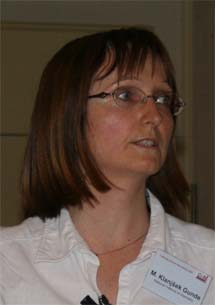
Dr. Marta Klanjsek Gunde
National Institute of Chemistry, Ljubljana, Slovenia
Title lecture
Dispersions of carbon black pigments in epoxy-based medium
Author
M. Klansjek-Gunde, N. Haubtman, M. Macek, M. Bester Rogac
Abstract
Epoxy-based nanocomposite systems are suitable for sensing materials in
capacitive chemical sensors. Suitable nanoparticles are dispersed
carefully within the epoxy-based photoresist in order to change the
electrical properties of the composite. This way the sensing material
can be optimized regarding to the chemical nature of analyte and its
dielectric constant.
Some types of carbon blacks have been applied. They are characterized by
different primary particle sizes, specific surface area and specific
resistance. The state of the dispersion of solid particles within the
polymer in the liquid state and the properties of the composite which is
formed after the UV-exposure was controlled together with the phenomena
occurring on the interaction zone between nanoparticle surfaces and
polymer matrix. Several properties of the prepared dispersions of carbon
black and condensed nanocomposites such as chemical composition, state
of the dispersion, viscosity of the liquid phase and resistivity were
considered. For the purposes of analysis, all the advantages of the
Fourier-Transform Infrared Spectroscopy and Scanning Electron Microscopy
were taken into account
Biography
Dr. Marta Klanjsek Gunde finished her PhD in physics at the University of Ljubljana, Slovenia. She is working as research associate at the National Institute of Chemistry in Ljubljana, Slovenia and has about 25 year experiences in material research. She is experienced in optical and vibrational analysis of infrared spectra of single crystals and thin solid films, including fundamental issues such as coupling of elementary excitations, lattice defects and dopant inclusions. She developed full optical analysis of IR spectra of semiconductor materials in bulk and thin film forms. During the past years she was extending her research on the optical effects in pigmented coatings where she apply scattering theories as well as colorimetric methods. Currently she is leading the research project on nanocomposites where the knowledge from microelectronic applications, that she was working with her colleague in the past, is connected with experiences in pigmented coatings.
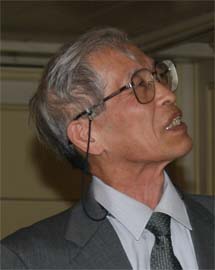
Professor Tsuginori Inaba
Chuo University, Tokyo, Japan
Title lecture
Double bonding strength due to pre-treatment on metal surface for plasma spray with low pressure arc after grit blasting
Authors
Masayuki Hara, Yuya Kubo, Koji Ogura, Toru Iwao, Shogo Tobe, Tsuginori Inaba
Abstract
Cathode spots of a low-pressure arc can remove oxide layers and
evaporate impurities on metal surfaces. Removal of the oxide layer using
cathode spots is expected to solve recent obstacles due to chemical and
mechanical cleaning methods. Various phenomena of cathode spots have
been investigated for pre-treatment of atmospheric pressure plasma spray
(APPS). This study treated the surface shapes of oxide and non-oxide
samples using a composite pre-treating method: cathode spots after grit
blasting. In addition, the samples are compared with conventionally
treated cathode spots and mechanical blasted surfaces.
Results show that roughness on the sample surfaces becomes higher in
concomitance with the initial oxide layer thickness. This fact reveals
the factors those dominate bonding strength on the pre-treated surface
using cathode spots of a low-pressure arc. Bonding strength becomes
higher in relation to the arithmetical mean height of the surface
roughness caused by the initial oxide layer thickness. Bonding strength
is higher when the mean spacing of profile irregularities is narrower.
The bonding adhesive strength after treatment using cathode spots after
grit blasting is greater than 90 MPa. However, cathode spot treatment
must be limited not to destroy the projection formed by melting after
grit blasting in an arc time up to 5s.
Biography
Tsuginori Inaba received the B. Sc., M. Sc. From Nagoya Institute of
Technoloty, Nagoya, Japan, in 1966 and 1968, respectively. He received
the Ph.D. degrees in engineering from Nagoya University in 1971. All in
Japan.
Currently, he is Professor and Director of Thermal Plasma Research
Center at Chuo University, Tokyo, Japan. In 2004 he worked at Minnesota
University and Muenchen Technical University. During 1978 and 1979, he
was a Guest Professor at Technical University Braunschweig in West
Germany. From 1971 to 1994 he worked at Central Research Institute of
Electric Power Industry (CRIEPI). From 1959 to 1965, he worked at
Mitsubishi Electric Corp. He joined Adeka Agath Chemical Co.Ltd. in
1965. All in Japan.
Dr. Inaba now heads a Technical Committee on Static Equipment of IEE
of Japan and the IEC TC32, SC32A and SC32B National Committees on Fuses.
In 1976, 1988, and 1995, he received IEE Japan awards for best articles.
In 1994 the IEE Japan best author award and in 2005 the IEE Japan best
author group award. He is a member of IEE of Japan, the Society of
Cryogenic Technologies in Japan, the Japan Institute of Metals(JIM),
IEEE in U.S.A. and so on.
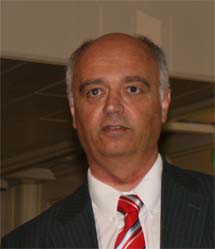
Rob Jans
AkzoNobel Decorative Coatings Europe, The Netherlands
Title lecture
A new reactive diluent for decorative paints in view of 2010
Authors
R.J.F. Jans, R.P. Klaasen, M. Meijer, H. Kelders, A. Lansbergen, M. Spierenburg
Abstract
Due to the upcoming legislation on VOC in 2010 the use of volatile compounds in Decorative paints will be further limited. This urges to develop new ways in formulating coatings. One way of achieving a lower VOC level is to make use of so-called reactive diluents. In contrast to normal solvents these diluents remain in the paint film and react with the alkyd binder. In this lecture the prerequisites for a good reactive binder are addressed. Moreover, the development of a suitable Reactive Diluent, matching these prerequisites is described. A special category of so-called Knoevenagel adducts, shows excellent performance. This performance is presented here. Also the effects of these diluents in the paint and paint film are described.
Biography
Education
- 1981-1985 Universiteit van Amsterdam
- PHD: Syntheses and Reactivity of Metal-sulphine Complexes, 1988
- 1974 - 1981: Vrije Universiteit
- Master Study: Inorganic chemistry
- Minor I: Organic Chemistry
- Minor II: Chemistry of Food and nutrition
- 1968 - 1974: Secondary school: Pius X College, Atheneum B
Professional career:
- 1986: Sikkens BV, Research chemist Automotive Support
- 1993: Manager Support and Development of Decorative paints
- 2002: Manager Technology Centre Decorative paints
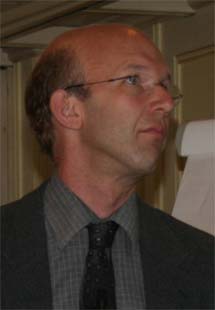
Professor Diethelm Johannsmann
Institute of Physical Chemistry, Clausthal University of Technology, Germany
Title lecture
Spatially resolved maps the stress distributions occuring during drying of latex dispersions
Authors
K. von der Ehe, A. Turshatov, J. Adams, D. Johannsmann
Abstract
The talk shows the results of spatially resolved stress measurements
on drying latex films. The sample is cast onto a flexible membrane,
which warps under the influence of stress. The back of the
membrane is used as a mirror. Imaging some kind of regular pattern
across this distorted mirror, one can infer the stress distribution from
the distortions of this image.
We find that the stress usually is laterally homogeneous in the initial
phase of drying. As the drying front proceeds from the rim to the
center of the drop, material moves from the center to the rim.
This movement is caused by a stress gradient. The flow is
analogous to Marangoni flow but the stress is not caused by surface
tension, but rather by the bulk film. The final droplet usually is
thicker at the rim than in the center. Also, the residual stress
is largest at the rim. In cases where the films crack during
drying, inhomogeneous stress distributions are often seen before the
film actually cracks. These results suggest that Marangoni flow
can lead to an instability which precedes cracking.
Measurements of non-radiative energy transfer (NRET) between donor and
acceptor fluorescent molecules located on different particles complement
these studies. NRET measurements give access to the amount of
polymer interdiffusion and the concommittant increase in mechanical
strength.
Biography
Education and Professional Experience:
- 1986 Degree in Physics from Heidelberg University
- 88 - 91 PhD-thesis at the MPI for Polymer Research, Mainz
- Awarded the "Prof.-Dr.-Jürgen-Geiger-Preis"
- 91 - 93 Feodor-Lynen-Fellow, UC Berkeley
- 93 - 02 Senior Research Fellow at the MPI for Polymer Research, Mainz
- since 02 Professor of Physical Chemistry at Clausthal University of Technology
Research Interests:
Polymer Coatings, Acoustic Sensors, Microtribology, Surface-attached
Hydrogels
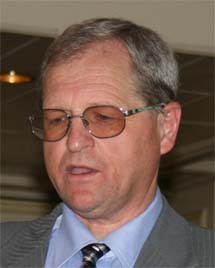
Dr. Alexander P. Kharitonov
Institute of Energy Problems of Chemical Physics (Branch) of the Russian Academy of Sciences, Chernoglolovka, Moscow Region, Russia
Title lecture
Enhancement of commercial properties of polymeric articles by direct fluorination
Authors
A.P. Kharitonov, L.N. Kharitonova, R. Taege, G. Ferrier
Abstract
Results of more than 25-years research of both fundamental features of
the direct fluorination of polymers (i.e. treatment of polymer surfaces
by gaseous fluorine and its blends), physical-chemical properties of the
surface modified layer and study of the possibilities to enhance gas
separation properties of polymeric membranes and modules, barrier
properties of polymeric articles and mechanical properties of
polymer-polymer fiber composites are reviewed.
More than 20 various polymers (polyolefines, polycarbonates, polyimides,
polysulfones, simple and complex polyethers, phenyl-containing polymers,
silicon-containing polymers, polyacrylates, co-polymers, etc.) where
studied. The following methods where used: FTIR spectroscopy,
spectroscopy in the visible and near UV region of spectra,
refractometry, electron microscopy, gas-chromatographic and volumetric
measurement of transport properties of polymeric membranes, measurement
of the surface energy, measurement of the permeability of liquids
through polymer films, “in situ” interference method of investigation of
the kinetics of formation of fluorinated layer, method of measurement of
the density of fluorinated polymer layers (over 0.5-10 micrometer
range).
The influence of treatment conditions (composition and pressure of the
fluorinating mixture, fluorination duration and temperature) on the
polymer chemical composition, thickness of fluorinated layer, density,
refraction index, surface texture and surface energy were investigated.
Kinetics of formation and termination of radicals, formed inside the
fluorinated layer, was studied. A theoretical model, describing the
kinetics and mechanism of the direct fluorination of polymers, has been
developed on the basis of obtained data.
A method to enhance the barrier properties of high density polyethylene
with respect to petrol-methanol and petrol-ethanol mixtures has been
developed. Direct fluorination was successfully applied to enhance
separation properties of polymer flat membranes and hollow fiber
membrane modules. Fluorine treated membranes have enhanced gas
separation selectivity, e.g. selectivity of He/CH4 and h5/CH4 separation
can be increased by a factor of several tens times as compared with
starting membrane. Fluorination of Kevlar fiber enhanced the thermal
stability and tensile strength of polymer-Kevlar fiber composite.
Biography
EDUCATION
- Master of Sci. in physics in 1973, Moscow Institute of Physics and Technology, Department of the Molecular and Chemical Physics, the USSR.
- Ph.D. (physical-mathematical sciences) in 1979.
- Doctor of Sciences (physical-mathematical sciences) in 2006.
POSITIONS AND DUTIES
- 1967-1973, 1973-1976- student and post-graduate student of the Moscow Institute of Physics and Technology (the USSR);
- 1976-1987- engineer, junior research scientist and senior research scientist, head of group at the Institute of Chemical Physics (Division) of the USSR Academy of Sciences;
- 1987-2005- senior research scientist at the Institute of Energy Problem of Chemical Physics (Branch) of the Russian Academy of Sciences.
- 2005-present- leading research scientist at the Institute of Energy Problem of Chemical Physics (Branch) of the Russian Academy of Sciences, Chernogolovka, Moscow Region, 142432, Russia.
RESEARCH ACTIVITIES
- 1978-present- fluorine chemistry, including:
- 1984-present- the modification of polymers by the direct gas phase fluorination (kinetics and mechanism of the formation of the fluorinated layer on the polymer surface, structure of fluorinated polymers, introduction of functional groups into the polymer structure, gas transport properties of fluorinated polymer membranes and their gas-separation properties, kinetics and mechanism of elementary stages of the chain process of the direct fluorination). Enhancement of gas separation properties of polymer membranes, barrier properties of polymer articles, adhesion properties pf polymers, mechanical and thermal properties of polymer composites.
- 1994-present- fluorination of fullerenes, nanoparticles and nanotubes.
- 1978-1984- the kinetics and mechanism of gas-phase elementary reactions in systems including fluorine, chlorine, oxygen, hydrogen etc..
- 1988-present- investigation of the physical-chemical properties of high-temperature superconductors subjected to the cooperative action of fluorine and ionizing radiation.
- 1973-1980- chemical and photo-recombination lasers.

Dr. Sviatlana Lamaka
University of Aveiro, Dep. Ceramics and Glass Eng., Aveiro, Portugal
Title lecture
Hybrid organic-inorganic sol-gel films as anticorrosion coatings for magnesium alloy AZ31B
Authors
S.V. Lamaka, A.F. Galio, M.L. Zheludkevich, L.F. Dick, I.L. Muller, M.G.S. Ferreira
Abstract
The main reason preventing enhancement of using of light magnesium
alloys in construction applications is their high corrosion
susceptibility. This work aims at creation and investigation of new
anticorrosion coating systems for magnesium alloy AZ31B.
The hybrid organic-inorganic sols were prepared by copolymerization of
3-glycidoxypropyltrimethoxysilane (GPTMS), titanium alcoxides and
additives which provide corrosion protection specifically for magnesium
alloy. The average thickness of sol-gel coatings, which were produced by
simple and fast dip-coating procedure, is 2 micron. However, even such a
thin sol-gel coating exhibits excellent adhesion to the substrate and
prevents corrosion attack of 3% sodium chloride solution for 2 weeks of
standard immersion test. No pitting appeared on the surface of coating
and magnesium substrate.
The morphology and the structure of the sol-gel films were characterized
with SEM/EDS and AFM techniques. Corrosion behaviour of AZ31B substrates
pre-treated with sol–gel derived hybrid coatings were tested by
Electrochemical Impedance Spectroscopy and Scanning Vibration Electrode
Technique. Different composition of sol-gel systems show enhanced
long-term corrosion protection of magnesium alloy.
Biography
Currently Sviatlana Lamaka is a post-doctoral researcher at the
University of Aveiro in Portugal. She made her PhD in Analytical
Chemistry at Belarusian State University in Minsk, Belarus. There she
has been teaching courses on General Analytical Chemistry and
Physical-Chemical Methods of Analysis.
Recently she has joined group of professor Mario Ferreira in Aveiro.
Currently her main interests are in the fields of Nanostructured
coatings for corrosion protection with self-healing ability; Organic
inhibitors for protection of aluminium alloys and Modification of AFM
probes.

Sheau-Hwa Ma
Dupont, Germany
Title lecture
Structured acrylic polymers and their use in coating applications
Authors
Sheau-Hwa Ma
Abstract
There has been very high level of interest in the area of controlled free radical polymerization from both the academics and the coating industry, and significant advancement has been made in areas like ATRP, NMP, and RAFT over the past years. These techniques have provided tools to more precisely control the size/MW and the shape of the polymer and given the ability to choose and precisely place the functional groups to derive unique properties. This has added a new dimension to coating formulation, which may enable us to better meet the increasing demands from both the customers and the environmental regulations. Examples will be discussed in more details.
Biography
Sheau-Hwa Ma, a native of Taiwan, graduated from National Cheng-Kung University, Taiwan, with a BS degree in Chemistry in 1974. She then went on to the United States and obtained her Ph.D. degree in the field of Physical Organic chemistry from Boston University in 1979. After a postdoctoral research program at Princeton University, she joined E.I. DuPont Company in 1981. Over the years she has worked for several business units and is currently associated with the Performance Coatings Business Unit at the Marshall Research Lab, Philadelphia, Pennsylvania. Her research interests include living polymerization, controlled free radical polymerization, structured acrylic polymers, pigment dispersant and dispersions, both waterborne and solvent borne systems, and their applications.
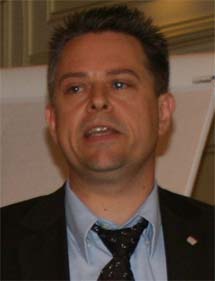
Dr. Frank J. Maile
Merck KGaA, Darmstadt, Germany
Title lecture
Orientation of transparent effect pigments and its influence on their appearance in polymer films
Authors
Dr. F.J. Maile, Dr. P. Reynders, Dr. M. Rosler
Abstract
Driven by trends in fashion, automotive and other consumer markets,
special effect pigments have a growing economic significance and can be
found in various industrial products and end-user applications. The main
effects are an angle-dependent colour and decorative textures.
The colouristic effects of pearlescent effect pigments rely on the
interplay between absorptive and interference effects in layered
structures deposited on platelet-shaped core particles. Their
performance of course depends much on the quality of these layers, but
the nature of the substrate cores - their chemistry, shape, size, size
distribution, and flawlessness - is also extremely important.
After an introduction to substrate-based effect pigments, we will
present the newest developments and production technologies in this
area. The relation between orientation of the pigment platelets and the
appearance of the final composite film will be discussed for different
polymer and lacquer films.
Biography
Dr. rer. nat. Frank J. Maile is a Senior Manager within the PLS
(Performance & Life Science Chemicals) department at Merck KGaA
Darmstadt, Germany.
After graduating in chemistry from the university of Stuttgart, Germany
he worked at the research center for pigments and paints (FPL e.V.) in
Stuttgart, Germany and the institute of applied macromolecular chemistry
at the university of Stuttgart for his doctorate (with Prof. Dr. Claus
D. Eisenbach). For his PhD thesis ("new application areas of SRET -
Scanning Reference Electrode Technique") he received the FARBE &
LACK (of Vincentz Verlag) and APi award (of the German Society of
Chemists, GDCh). Within the business unit PLS/PIGM/Coatings he is
responsible as a group leader for the technical service
(industrial/automotive paint customers) for effect pigments. Ca. 40
publications/conference contributions.
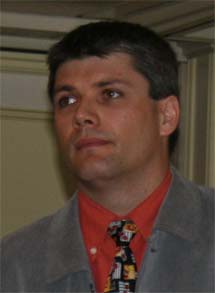
Jacky Mallégol
Arcelor Research Industry Liège, Belgium
Title lecture
UV weathering of prepainted steel
Author
J. Mallégol
Abstract
One of the main markets for prepainted steel is the construction market,
which implies an outdoor weathering. Guarantees for the prepainted
steels mainly include the corrosion resistance of panels and the
aesthetics of paint (colour change and gloss retention).
We will present in this lecture some examples of our studies carried out
in the field of durability (and more especially in UV weathering) of
prepainted steel, with a focus on: correlation between UV weathering in
accelerated lab tests and in natural outdoor exposure relationship
between the UV degradation of paint and the corrosion resistance of
prepainted steel.
The UV weathering of a first selection of painted panels has been
performed, with various UV testing devices (WOM, QUV and SEPAP). The
photo-degradation has been followed with FTIR spectroscopy,
micro-hardness, UV-visible spectroscopy, colorimetry and gloss
measurements. The influence of the water (hydrolysis of oxidation
products) has been included in the tests that were carried out without
condensation/aspersion phase. The test fitting in the best way the
natural evolution up to 10 years in Hendaye (South West of France) has
been determined, and then applied on a larger series of samples for
validation.
For investigating the correlation between paint photo-degradation and
corrosion resistance of prepainted steel, panels have been exposed to UV
irradiation prior to salt spray exposure. The modification of the
barrier effect has been determined with EIS, while measuring the
oxidation profiles in the paint (FTIR spectroscopy). The blistering on
the overall surface during salt spray exposure has thus been reproduced
on some panels where the paint had a very poor resistance to UV
weathering, and exhibited pronounced oxidation profiles.
Professional CV of Jacky Mallégol
Dr Jacky Mallégol holds a Chemical Engineering Degree and a Ph.D. in Physical Chemistry from the University of Clermont-Ferrand in France. His Ph.D. research dealt with the curing and degradation mechanisms of oil-based paints. During a first postdoctoral training at the National Research Council of Canada in Ottawa, he worked on polyethylene packages and their stability upon gamma-irradiation. He then started in 2000 a second postdoc at the University of Surrey in England, working in collaboration with UCB Chemicals on film formation in water-based pressure-sensitive adhesives. In 2002, Dr Jacky Mallégol joined a major research centre of the Arcelor group located in France, working in the fields of organic coatings adhesion and of UV curing. In 2004, he has moved to Arcelor Research Liège (Belgium), in the Organic Coatings department, where he is leading projects dealing with surface functionalities, new ways of curing and UV weathering of prepainted steel.
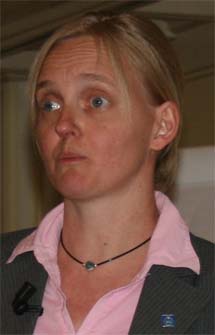
Professor Eva Malmström
KTH, Department of Fibre & Polymer Technology, Stockholm, Sweden
Title lecture
Covalent surface modification by controlled polymerization
Authors
Eva Malmström, Josefina Lindqvist, Daniel Nyström, Hanna Lönnberg, Linda Fogelström, Anna Carlmark.
Abstract
Surface confined polymerizations have become readily accessible by the development of controlled polymerization techniques, such as atom transfer radical polymerization (ATRP). ATRP allows for the concurrent growth of many adjacent chains with appropriate control over chain ends, molecular weight and molecular weight distribution. Fibres from natural sources, such as cellulose, are receiving increasing interest. To be successfully used in composites for instance, the fibers often need to be surface modified in order to reduce water uptake and enhance the compatibility with the matrix. This can be accomplished by grafting the fibre surface with polymers. Both ATRP of vinyl-type monomers as well as ring-opening polymerization of cyclic monomers can be used. By the appropriate choice of monomers it is possible to transform highly hydrophilic biofiber-based substrates into hydrophobic or even superhydrophobic surfaces.
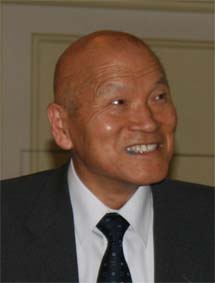
Akira Matsumoto
Department of Applied Chemistry, Faculty of Engineering, Kansai University, Suita, Osaka,Japan
Title lecture
Design of network polymers based on the mechanistic discussion of multivinyl crosslinking polymerization
Author
A. Matsumoto
Abstract
We have been concerned with the network formation in the free-radical
crosslinking polymerization and copolymerization of multivinyl monomers,
especially those including diallyl esters and dimethacrylates, by
focusing our attention on the mechanistic discussion of the deviation
from Flory-Stockmayer (FS) gelation theory. There are two extreme
crosslinked polymers as an ideal network polymer governed by FS theory
and a microgel greatly deviated from the theory.
We extended the above mechanistic discussion to the development of novel
network polymers; (i)amphiphilic network polymers consisting of short
primary polymer chains and long crosslink units with opposite
polarities, (ii) semi- or full-IPN formed via the topological crosslink
between liner polymer and net polymer or net polymers having loop
structures as extreme precursors of microgel-like network polymers with
oligomeric primary polymer chains, (iii) inhomogeneous network polymers
having reactive crosslinked polymer nanoparticles, i.e.,
pseudo-microgels, as crosslink sites, and (iv) network polymers with
abundant dangling chains consisting of centipede-type primary polymer
chains originated from multiallyl crosslinking polymerization.
Biography
Akira Matsumoto
Present Position: Professor, Department of Chemistry and
Material Engineering, Faculty of Chemistry, Materials and
Bioengineering, Kansai University
Education:
- 1964, Bachelor of Engineering (Department of Applied Chemistry, Faculty of Engineering, Osaka University)
- 1972, Doctor of Engineering (Osaka University)
Employment:
- 1964, Instructor, Department of Applied Chemistry, Faculty of Engineering, Kansai University;
- 1977, Lecturer;
- 1983, Associate Professor; 1990-Professor
- 1977 Oct. - 1978 Mar., AdjunctPostdoctoral Associate, University of Florida, U.S.A.
- 1984 Jun., Visiting Scholar, Peking University, China
- 1985 Apr. - 1986 Mar., Visiting Associate Professor, University of Florida, U.S.A.
- 1988 Sep. & Oct., Visiting Professor, Catholic University of Leuven, Belgium
Research Interest:
- Free-radical crosslinking polymerization, Cyclopolymerization,
- Allyl polymerization, Emulsion polymerization, Amphiphilic polymer, Microgel, Hydrogel ("Molecular design of vinyl-type network polymers with high performance and high functionality")
Publications:
183 papers; 35 reviews and books; 31 patents; 86 presentations at
International Conferences including 22 invited lectures
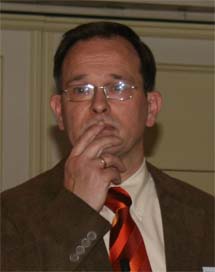
ir. Leendert Molhoek
DSM Resins, Zwolle, The Netherlands
Title lecture
Amorphous polyamide resins; new versatile binders for fast curing powder coatings
Authors
L.J. Molhoek, J. Dutman
Abstract
Crystalline Polyamides are well known binders for thermoplastic powder
coatings. They combine properties such as toughness, scratch and
chemical resistance. The high melting point and viscosity, however
limits the application of these binders for powder coatings.
DSM has developed a series of amorphous polyamide resins, which can be
crosslinked with all the known hardeners for powder paints. This results
in thermosetting binders for powder paints, which combine the properties
of thermoplastic nylons with the advantages of a thermosetting system.
These thermosetting polyamide binders show some of the previously
mentioned properties such as an excellent ratio of hardness and
flexibility, scratch and chemical resistance together with good
application properties such as gloss, appearance and flow. This paper
will show you some of the chemical structures of these binders, their
physical properties and application results in powder coatings.
Additionally, some of these thermosetting powder paints show an
unexpectedly high curing speed. It appears to be possible to develop
powder paints, which are able to be cured at low temperatures, retaining
most of the properties.On the basis of several chemical and
physical analysis techniques, the cure characteristics of these new
materials at lower temperatures, will be discussed.
Biography
Leendert Molhoek studied organic chemistry at the Technical
University of Delft. He graduated in 1977 (Prof. Beijerman).
He joined DSM Resins in 1979 as a research chemist and holds different
positions in Research and Development. The last 15 years he is involved
in new, innovative projects concerning powder coating resins. Since 2003
he is appointed as a Competence Manager polycondensation chemistry for
the Performance Materials cluster of DSM Corporate.
His field of experience is polycondensation chemistry in general and
coating resins in particular.
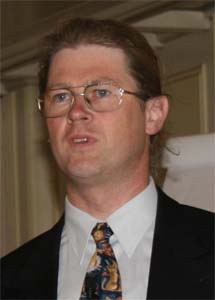
Dr. Rolf Nothhelfer-Richter
Forschungsinstitut fuer Pigmente und Lacke e.V., Germany
Title lecture
Investigations of the photoactive activity of pigments and pigmented organic coatings using the reactor method
Authors
R. Nothhelfer-Richter, M. Wanner, W.Ph. Oschsner, C.D. Eisenbach
Abstract
Finishing industry and end-users of construction and wall
paints are calling for additional values like reduced soiling or self
cleaning properties. One approach is to modify coatings by addition of
highly photocatalytically active titanium dioxide (TiO2) which degrades
organic compounds in the presence of UV-light to CO2 and water. Contrary
to inorganic substrates like glass and ceramics [1, 2] where TiO2
activated surfaces are well known, an organic coating has to be
protected against self degradation.
In this context a new testing technique based on a
reactor method has been explored and is being evaluated for the
determination of the photocatalytic activity of pigments and pigmented
organic coatings. The investigations include both the stability of the
coating against self decomposition and the permanence of the
photocatalytical effect.
In this contribution a test chamber method is presented which is based on
the setup used by Searle [3]. The samples to be tested for their
photocatalytic activitiy are placed in a chamber where various climatic
and atmospheric conditions can be applied and controlled including
exposure to model pollutants. During irradiation by UV light, a FTIR
spectrometer records the amount of pollutants and their decomposition
products. This technique does not only allow to follow the
photocatalytic activity of the pigment and pigmented coating regarding
the decomposition of solid, liquid and gaseous model pollutants, but
also to determine the photocatalytic stability of coatings by detecting
the decomposition products of the polymeric binder material. The
quantitative in-situ IR analysis enables the establishing of kinetic
models. The comparative data evaluation is meant to gain scientific
knowledge about adsorption and decomposition processes of
photocatalytically active coatings components and formulations as a
basis for future coatings technologies.
keywords: photocatalytic activity, coatings stability, self-cleaning
- Fujishima, A., Hashimoto, K., Watanabe, T., TiO2 Photocatalysis Fundamentals and Applications, BKC, Inc. Tokyo (1999)
- 4th International Workshop on the Utilization and Commercialization of Photocatalytic Systems, Coatings for Clean Surfaces, and Water and Air Purification Methods, Veranstalter: EJIPAC, Saarbrücken (2004)
- Seale, I.R., Titanium dioxide pigment photocatalysed degradation of PVC and plasticised PVD coatings, Engineering Doctorate Thesis, University of Wales Swansea (2002)
Biography
Dr. Rolf Nothhelfer-Richter
- born 1963
- studied physics at the university of Ulm with main focus polymer physics and mechanical analysis
- phd 1996, topic "Dynamic-mechanical characterization of heterogeneous rubber blends filled with carbon black"
- post doc at the Institute for dynamic Materials Testing (IdM) in Ulm
- since 2001 at the Research Institute for Pigments and Coatings (FPL), now head of physics department
- Main research areas: scratch resistance of coatings, mechanical properties of coatings, surface topology of coatings, photocatalysis
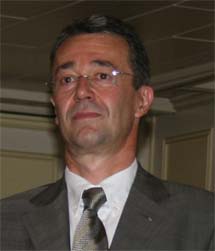
Dr. Jürgen Omeis
BYK-Chemie GmbH, Wesel, Germany
Title lecture
The evolution of structured polymers for coating applications
Author
J. Omeis
Abstract
The major parts of a coating comprise polymeric resins, pigments,
fillers and solvents when applied. Nevertheless, a lot of important
properties are basically driven by surface active effects, such as
colour, shade, deaeration, surface polarity, e.g.
These properties are dramatically influenced by amphiphilic copolymers
specifically interacting with interphases.
The range of suitable molecules is rather broad and varies in terms of
chemical composition, molecular weight and structure. Within this
enormous variety of additive chemistry it is the scope of this review to
demonstrate the emerging synthetic capabilities complying with
well-defined polymeric structures. These structures can vary from simple
binary copolymers to highly sophisticated block and star polymers for
high end applications like colour resists in the optoelectronic
industry.
Biography
CV Dr. Jürgen Omeis
Born 1956, Nürnberg
Education at University of Erlangen and University of Freiburg
- Diploma in Organic Chemistry
- Ph.D. Thesis in Macromol. Chemistry
1986 - 1995 Röhm, Darmstadt Project Manager
- Liquid Crystalline Polymers
- Polymer Blends
- Polymer Additives
1995 - 2004 Fuchs Petrolub, Mannheim
- Head of Global Automotive Development
- Green Chemistry for Lubricoats
- Development and Product Management for Automotive Lubricants
Since 2005 BYK-Chemie, Wesel
- CTO
- Global responsibility for R + D of Paint and Plastic Additives
- More than 20 patents worldwide, several publications and articles.
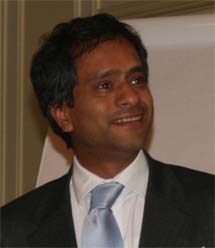
Dr. Mark Plehiers
Sigma Coatings, Belgium
Title lecture
Synthesis of silyl acrylates for marine coatings
Author
M. Plehiers
Abstract
The constant need for improving the performances of the products
associated to the dramatic growth of environmental regulations force the
resin and paint manufacturers to keep on developing more effective and
less toxic technologies. For example, the now-effective TBT ban of
antifouling coatings induced a considerable pressure on paint
manufacturers to develop and produce tin-free systems. One of the most
attractive tin-free technologies is based on the use of silyl acrylates
as key monomers for self polishing systems.
We will review in this presentation the chemistry developed for the
production of these new functional silanes. We will develop some of the
new concepts developed by SigmaKalon in the field of silane and
polysiloxane chemistry. These offer advantageous alternatives to the
conventional processes known so far and allow the development of new
products for Marine and Protective Coatings.
Biography
Curriculume Vitae Mark Plehiers
- 1995 : PhD in Organic Synthesis, Synthesis of Natural Products, University of Brussels, ULB, Belgium
- 1995-2001: Post Doctoral Research Member at University of Brussels, ULB: In Organic Synthesis of Biocides and of Antifouling Agents
- 2001-2005: Project Leader at SigmaKalon Business Unit Marine and Protective Coatings: Development of New Hydrolysable Monomers and Binders
- 2006-now: Manager of the R&D Resins Department in Manage (SigmaKalon Belgium)
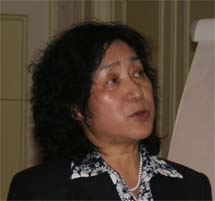
Professor Wenfang Shi
Department of Polymer Science and Technology, University of Science and Technology of China, Hefei, Anhui, P.R. China
Title lecture
Hyperbranched acrylate prepolymers and their potential applications for UV coatings
Author
W. Shi
Abstract
Owing to the unique architecture such as compact 3D structure, high functionality and little chain entanglement, hyperbranched polymers have attracted considerable attention as materials with new application potentials. A series of hyperbranched polymers end-capped with (meth)acrylic groups were synthesized as UV curable prepolymers for coating applications, such as water thinnable and dispersible systems, powder coatings, organic/inorganic hybrid composites. The specific properties that hyperbranched polymers and their UV cured films exhibit have also been described in detail in comparison with linear polymers.
Biography
- graduated with BS from the Department of Modern Chemistry, University of Science and Technology of China (USTC) in July of 1970.
- studied at the Department of Polymer Technology, Royal Institute of Technology (KTH), Stockholm, Sweden as a visiting scholar under Supervisor Professor Bengt Rånby during 1985-1987 and 1992-1994.
- awarded Ph. D. degree in October of 1994 from the Department of Polymer Technology, KTH.
- received the full professor position in 1996 at the Department of Applied Chemistry, USTC.
- Vice President of RadTech China (1995-2006)
- President of RadTech China (2006-)
- Deputy Director of Radiation Technology Institute, USTC (1998-)
Research Interests
- Synthesis and applications of dendrimers/hyperbranched polymers
- Organic nonlinear photorefractive materials
- Radiation curing of organic coatings
- Modification of polymer materials
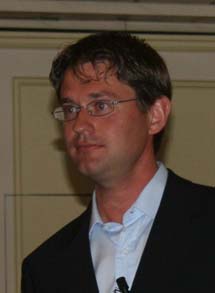
Willem Jan Soer
Eindhoven University of Technology The Netherlands
Title lecture
Novel Crosslinking Systems for Surfactant-free Latexes Based on Maleic Anhydride Containing Polymers
Authors
Willem Jan Soer, Weihua Ming, Cor E. Koning, Rolf A.T.M. van Benthem
Abstract
We report the successful preparation of surfactant-free, artificial latexes based on maleic anhydride containing polymers. The interactions between two (potential) crosslinkers and the various latexes were studied. It was found that latexes with particle diameters of about 150 nm and a ζ-potential of -70 mV could be obtained for 3 different maleic anhydride containing polymers. When adipic dihydrazide (ADH), a water soluble crosslinker, was added to these latexes, no differences in particle size or ζ -potential were found. When 1,6-diaminohexane (DAH) was added to these latexes, it was found to interact with the polymer particles, indicated by a change in color as well as a large decrease in (absolute) ζ-potential. It was shown that no free DAH was present after addition to the latex, while free, non reacted ADH was shown to be present. Kinetic studies of the crosslinking mechanism revealed that (irreversible) imide formation between anhydride and ADH took place at temperatures of 90 °C and above. 1,6-Diaminohexane (DAH) formed imides at significantly higher curing temperatures, >130 °C. Homogenous films could be formed from these latexes when heated above the respective Tgs of the polymers.
Biography
Willem Jan Soer got his M.Sc. diploma in Chemical Engineering at the University of Twente in 2002, where he graduated in the group of Prof. Dr. Julius Vancso. The topic of his graduation research was the synthesis of organo-metallic amphiphilic block copolymers and the self assembly of these polymers for nanotechnological applications. After that he worked one year in the group of Prof. Dr. Bert Meijer at the Eindhoven University of Technology where he worked on the synthesis of conductive polymers for blue-LED applications. In December 2003 he started his work as a Ph.D.-student with a project on waterborne anti-corrosion coatings in the groups of Prof. Dr. Cor Koning and Prof. Dr. Rolf van Benthem, which he hopes to finish early 2008.
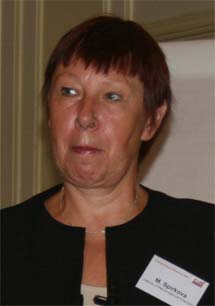
Dr. Milena Spírková
Institute of Macromolecular Chemistry, Prague, Czech Republic
Title lecture
The view from the core onto the surface of self-assembled nanocomposite coatings
Authors
M. Spírková, J. Brus, J. Baldrian, M. Slouf, A. Strachota, J. Kotek
Abstract
The contribution will be aimed the multidisciplinary characterization of hybrid organic-inorganic nanocomposite coatings synthesized by two independent processes: sol-gel process (inorganic in-situ structure build-up) and polyaddition reactions (organic polymeric network formation). Moreover, nanoadditives (colloidal silica, montmorillonite) were used as well in some cases. Solid-state NMR spectroscopy, transmission electron microscopy, small- and wide-angle X-ray scatterings studied "core" properties, while static and dynamic mechanical analyses were used for comprehensive, "bulk" properties of the material. Various microscopy methods (atomic force, light, scanning electron) were utilized for surface characteristics of coatings prepared in the presence/absence of nanoadditives. Three independent methods for surface hardness determination were used as well.
Biography
MSc: 1977, PhD: 1988
Professional Experience
Post-doctoral stay, Université de La Rochelle France, 1 year
Visiting scientist, Université de La Rochelle France, 5 months
Visiting scientist, Chalmers techniska högskola Göteborg Sweden, 2
months
Visiting scientist, Rzeszow University of Technology Poland, 1 month
Research interest
Nanocomposites, coatings and films, sol-gel processing, atomic force
microscopy, preparation and characterization of polymer (mainly
organic-inorganic, epoxy and polyurethane) systems, kinetics and
reaction mechanism of polymer (and low-molecular model substance)
formation, mechanical properties.
Publications
Since 1987: 46 original papers published in international journals
with 244 citations (source: Web of Science). Ca. 90 contributions
presented at international conferences and symposia.

Jeffrey M. Stubbs
DSM NeoResins, Wilmington, USA
Title lecture
The dynamics of morphology development in multi-phase latex particles
Authors
J.M. Stubbs, D.C. Sundberg
Abstract
The use of multi-stage emulsion polymerization to produce particles
containing multiple polymer phases is widespread throughout the
coatings, impact plastics and adhesives industries. Such composite
particles often improve various application properties compared to
related single phase latexes or latex blends. However, the properties
obtained depend in large part on the morphology of the multiphase
particles. This creates incentive to understand the underlying
mechanisms that drive morphology development in these particles as they
are formed in the polymerization reactor. Much research and attention
has been devoted to understanding the thermodynamic factors that
influence morphology control, but in fact the majority of systems are
produced under kinetic control, resulting in non-equilibrium structures.
There are three main kinetic factors involved as the morphology develops
during the second stage polymerization. These are 1) penetration of
polymer radical chains into the particle interior after entry from the
water phase, 2) phase separation of immiscible polymer chains produced
in the different polymerization stages and 3) spatial rearrangement of
phase separated domains.
The factor (or combination of factors) that is dominant will vary from
one system to another and is highly dependent on the glass transition
temperatures of the different polymers in relation to the reaction
temperature. This presentation will provide an overview of the effects
that each of these kinetic factors can have on particle morphology using
specific experimental examples. It will be shown that one can predict
which factor will be controlling, and thus estimate what the resulting
morphology will be, by quantifying the diffusion rates of oligomer and
polymer chains under the conditions prevalent during the polymerization.
Biography
Degrees:
All from the University of New Hampshire, Durham, NH
- Ph.D. in Materials Science, May 2005
- M.S. in Chemical Engineering, May 2000
- B.S. in Chemical Engineering, December 1996
Received M.S. and Ph.D. degrees under the supervision of Prof. Donald
Sundberg and was employed as a research scientist in Prof. Sundberg's
lab until August 2006. Currently employed by DSM NeoResins+ as a
research scientist in the Emulsions R&D group in Wilmington,
Massachussetts.
Research interests include control and characterization of composite
latex particle morphology, emulsion polymerization mechanisms and
kinetics and diffusion.
Co-authored over 15 papers on the topic of morphology control in
multiphase latexes and presented several papers at international
conferences.
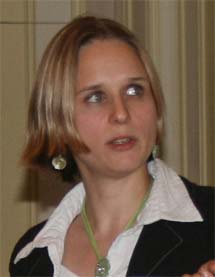
Katia Studer
Ciba Specialty Chemicals Inc. Basel, Switzerland
Title lecture
Novel curing agents: thermal radical initiators as viable alternatives to peroxides
Authors
K. Studer, P. Nesvadba, T. Jung, J. Benkhoff, K. Powell
Abstract
Stable 1-pack coating systems are gaining importance at the expense of
short-potlife 2-pack formulations. Two processes can initiate the cure
mechanism: the action of heat and the action of UV light. The use of
heat has traditionally been the more popular process, as UV-curing still
requires some investment and process modification on the part of
customers willing to enter this market. In contrast to UV-curing,
thermal curing ensures homogeneous cure on large 3D surfaces, as a
result of the uniform distribution of heat all over the substrate.
Thermal curing of 1-pack coating systems is usually induced by
polymerization of acrylates set off by peroxide initiators. The extreme
exothermic reactivity of peroxides can result in an explosion if they
are stored under unsuitable conditions (temperature increase). Another
major but less dangerous drawback to using peroxide-containing 1-pack
systems is their tendency to gel prematurely. The coating industry is
therefore increasingly demanding a safe alternative to peroxides, i.e.
non-explosive thermal radical initiators that combine good thermal
stability and curing at relatively low temperature.
This paper describes a novel class of curing initiators, non-peroxide
thermal radical initiators (TRI), and gives details of their reactivity,
stability and coating performance when they are incorporated in 1-pack
acrylate functionalized coating formulations.
Biography
Katia Studer completed her PhD thesis in 2004 under the direction of Prof. Decker/University of Mulhouse. The same year, she joined Ciba Specialty Chemicals as a Post Doc and got a permanent position in 2005 as technical specialist in the New Technologies Group - Technology Center Business Line Coatings. Since April 2007, she is responsible of the Skill Center Advanced Curing and Protection within the Technology Center Business Line Imaging and Inks.
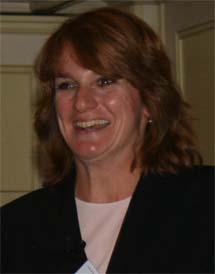
Janice L. Tardiff
Ford Research and Advanced Engineering, Ford Motor Company, Dearborn, USA
Title lecture
Automotive pretreatment - limitations of existing technology and enablers for future technology
Author
J.L. Tardiff
Abstract
The primary purpose of the automotive paint pretreatment process is to
provide good adhesion of subsequent paint layers to the metallic
substrate. Zinc phosphate is the pretreatment chemistry most
widely used by automotive manufacturers and under good processing
conditions has provided a stable base for subsequent paint layers.
However, as a greater variety of metallic substrates are used for
automotive body components, the capability of zinc phosphate is being
tested. The crystalline structure of zinc phosphate varies
depending on the substrate and the effect of this morphology variation
on paint adhesion will be discussed.
Substrate cleanliness also effects crystalline morphology, which then
affects paint appearance and quality. As alternatives to zinc
phosphate are considered for future pretreatment systems, cleanliness of
the substrate as it is exposed to the pretreatment chemistry becomes a
key attribute. Methods for practical and effective cleaning of
vehicle bodies and removal of debris from the pretreatment process will
be discussed. The benefit of improved cleaning is a more
consistent zinc phosphate process today and an enabling methodology for
future pretreatment technologies.
Biography
Ms. Tardiff is a paint technical expert at Ford Motor Company. She
holds a B.A. in Chemistry from Kalamazoo College and a M.S. in Chemical
Engineering from Michigan State University. She has been at Ford
Motor Company for 14 years, conducting project work focused primarily on
advanced technologies related to the paint application process.
Her positions within Ford have varied from Research to Manufacturing,
giving her experience in the development, implementation, and
maintenance of new technologies into the automotive painting process.
Current project interests include pretreatment to substrate adhesion and
the effects of process variability on pretreatment quality, pretreatment
process control methodologies, electrocoat deposition simulation tool
development, and automotive paint curing simulation tool development.
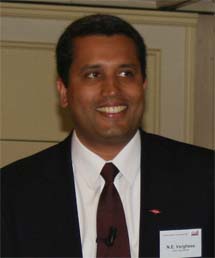
Nikhil Verghese
Epoxy R&D, Dow Chemical Company, Freeport, Texas, USA
Title lecture
The effect of rigid inorganic fillers on the mechanical and thermo-mechanical properties of epoxy thermosets: experimental and theoretical considerations
Authors
N. Verghese, D. Reuschele, M. Marks, R. Zeigler, K. Thomas, H. Pham
Abstract
While epoxy thermosets are commonly used and are best known for their
high glass transition temperature (Tg), creep resistance, environmental
resistance and high stiffness in almost all applications, some kind of
inorganic, rigid additive is incorporated into the formulation.
This is usually either in the form of fillers or pigments. These
inclusions provide a variety of benefits ranging from color, low
expansion coefficient, reduced moisture uptake, increased stiffness and
most importantly lowering cost. One of the major problems however is
that they also cause the thermoset to become more brittle and if not
treated carefully could create deleterious performance issues.
In this paper we will present our findings from work that was performed
recently to quantify the effect of some traditionally used macroscopic
filler types namely wollastonite, feldspar and barites in epoxy resin
based formulations. The thermoset resin system was carefully
chosen to be controlled from a chemistry point of view and includes the
use of DER TM
332 epoxy resin, bisphenol A as the chain extender and
tris(4-hydroxyphenyl)ethane (THPE) as a crosslinker. In addition
to the effect of filler type, the effects of filler volume fraction and
interface modification will also be studied. Experimental data and
trends pertaining to Tg, stiffness, tensile stress-strain deformation,
fracture toughness and thermal expansion coefficient will be discussed
along with detailed failure analysis via microscopy. Finally,
traditional composite based micro-mechanics models will be applied and
compared to the experimental data to predict stiffness and thermal
expansion coefficient as a function of filler type and volume fraction.
Biography
Dr. Nikhil Verghese is currently a Senior Research Specialist at The Dow Chemical Company. He joined Dow in 2000 and worked closely for the first 6 years with the Epoxy Business to provide fundamental material science based solutions in the areas of electrical laminates, composites and coatings. He is currently located in Auburn Hills, Michigan with the Dow Automotive business as a new business development project leader. His research interests are polymer deformation and fracture, viscoelasticity, composite mechanics and durability and general structure-property relationships for polymers. He received his B.S. degree in Mechanical Engineering from India, M.S. degree in Material Science and Engineering and his Ph.D. in Materials Engineering and Science from Virginia Tech in Blacksburg, Virginia, USA.

Di Wu
Eindhoven University of Technology, The Netherlands
Title lecture
Nature-inspired Superhydrophobic Coating
Authors
D. Wu, W. Ming, R.A.T.M. van Benthem, G. de With
Abstract
The development of superhydrophobic coating (water contact angle above 150°) is driven by the promise of self-cleaning properties of such coatings, which has enormous industrial potential. Nature has developed such self-cleaning surfaces, for instance the lotus leaves. Generally, the super-hydrophobic surface is obtained by the combination of a hydrophobic surface and a high surface roughness.
By mimicking the lotus leaves, a Layer-by-layer (LbL) approach was developed to prepare superhydrophobic surface, with the aim of improving the mechanical robustness of the film. Epoxy-based films were partially cured to a proper extent, followed by deposition of silica micro particles. After that, the films were completely cured. Subsequently, silica nano particles were grafted on the micro particle surface through amine-epoxy reactions. Finally, the surfaces were modified with a layer of PDMS or fluorinated monolayer to gain their superhydrophobicity. Superhydrophobicity and lipophobicity were achieved on those films.
Biography
Di Wu got his M.Sc. diploma in Chemical Engineering at the University of Twente in 2003, In September 2003 he started his work as a Ph.D.-student with a project on the Development of superhydrophobic self-cleaning coating and superhydrophobic textile by mimicking lotus leaf in the group of Prof. Dr. Rolf van Benthem. His defence is scheduled 8 October 2007.
